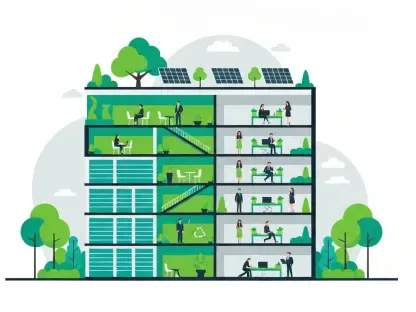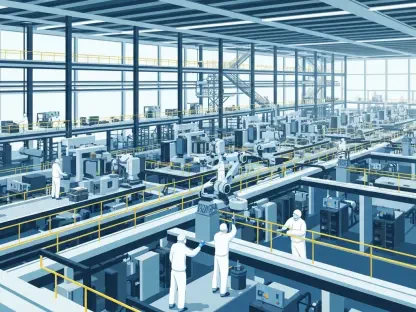Over the past few years, the construction industry has witnessed a remarkable shift towards digitalization, with a particular focus on enhancing project collaboration and efficiency through innovative software solutions. This rapidly evolving sector is poised to experience significant growth, with projections indicating an increase from USD 3.4 billion in 2023 to an impressive USD 7.5 billion by 2032. This growth trajectory is driven by a compound annual growth rate (CAGR) of 9.2% from 2025 onwards. As construction projects become increasingly complex and interconnected, the demand for advanced digital tools that streamline processes and enhance collaboration has never been greater.
The Need for Integrated Model-Based Planning
The Importance of Visualization in Construction
Integrated model-based planning tools have become essential for construction stakeholders, offering a comprehensive way to visualize workflows early in project cycles. These tools enable the identification of potential conflicts before execution, fostering team alignment and supporting predictive planning. Providers are enhancing their platforms to ensure transparency, minimize delays, and facilitate secure data sharing throughout project lifecycles. The widespread adoption of these advanced digital practices is revolutionizing how construction projects are managed, offering benefits that extend beyond mere efficiency gains.
The necessity for such tools is particularly pronounced in large-scale projects where multiple teams and systems must work in tandem. By leveraging integrated model-based planning, construction firms can align diverse teams, thereby reducing the likelihood of bottlenecks and ensuring that each phase of a project aligns with the overall objectives. Such integration not only optimizes resource allocation but also supports proactive decision-making through predictive analytics, which are essential for maintaining timelines and budgeting.
Embracing Cloud Technologies
Cloud-hosted platforms have emerged as a pivotal trend, offering real-time access to project data, improved scalability, and the integration of intelligent automation technologies. These platforms provide predictive insights and significantly reduce manual intervention in planning, scheduling, and reporting processes. Mobile interfaces have also gained prominence, allowing field teams to report progress and receive updates immediately, making them indispensable in modern construction sites. Additionally, automated systems, often requiring connectivity with sensor networks, enhance equipment monitoring, improving site safety and maintenance planning.
The shift to cloud technologies has brought multifaceted improvements to the construction industry, enabling teams to operate more cohesively across various geographic locations. By employing cloud platforms, construction enterprises can harness the benefits of automation, freeing up vital human resources to focus on critical tasks that require creative problem-solving and strategic planning.
The Role of AI in Construction
Predictive Analytics and Risk Management
Artificial Intelligence (AI) is a transformative force within the construction software market, leveraging predictive analytics to offer real-time insights. By examining historical project data alongside current inputs, AI forecasts potential delays, resource needs, and risk scenarios. An illustrative application of AI is its capability to analyze equipment performance and maintenance history to proactively schedule services. Such proactive measures reduce unplanned downtime and align maintenance activities with project timelines, ultimately preserving both time and capital.
AI’s application extends beyond just predictive measures; its ability to mitigate risks by forecasting potential setbacks enhances project resilience. This predictive prowess not only aids in adhering to stringent deadlines but also in managing large-scale projects seamlessly. AI tools have begun to evolve from merely reactive measures to systems capable of spearheading proactive interventions.
Enhancing Collaboration Through AI
AI’s utility in construction is not solely limited to risk management but also extends to enhancing overall project collaboration through intelligent data analysis and synthesis. By transforming large swathes of data into actionable insights, AI enables better communication among teams, fostering an environment of cooperation and efficiency. General contractors, who traditionally require robust platforms integrating various project aspects, are increasingly adopting AI to streamline processes.
The success of projects hinges on the ability to foster effective communication and collaboration, a challenge readily met by AI-enabled tools. By enhancing the flow of information across teams and ensuring that critical insights are shared in a timely manner, AI supports a more cohesive operational dynamic. This enhancement in communication translates into tangible improvements in productivity and project completion rates.
Market Dynamics and Trends
Growth in Different Regions
The construction software market is not monolithic but instead characterized by varied growth rates across different regions. North America continues to lead the charge in digital adoption, driven by a strong demand for efficient, integrated construction solutions. The complexity of projects in this region demands not only robust project planning tools but also innovations that enhance safety and compliance with regulations.
Within North America, the United States is at the forefront, with its demand for advanced software driven by the presence of large-scale projects and stringent safety regulations. The integration of AI tools aimed at improving site safety and compliance reflects the growing appreciation for technology’s role in achieving project goals. In contrast, Canada’s focus on integrating software to track environmental metrics aligns with its progressive stance towards sustainability and green-building practices.
Proliferation in Asia Pacific and Europe
Meanwhile, Asia Pacific’s construction industry is fueled by government-led smart city initiatives and a strong emphasis on sustainability. These projects facilitate the adoption of digital tools that support better design validation and resource management. Japan exemplifies the trend with national programs promoting digital solutions to combat labor shortages and ensure safety, pointing towards an increasing reliance on automation and digital tools.
Europe is not left behind; regulatory pressures for sustainability and digital mandates are spurring growth in the construction software market. The EU Green Deal and national policies demanding energy-efficient designs have prompted the adoption of BIM (Building Information Modeling) and other analytical tools. Countries like Germany and Spain are pivotal drivers of this trend, implementing BIM for public projects and sustainability-aligned renovations.
Future Considerations and Challenges
Encouraging Innovation Amid Obstacles
Globally, there is a burgeoning demand for integrated project lifecycle management solutions that streamline planning, execution, and reporting processes. However, the market faces challenges, notably high initial costs and customization requirements which can be particularly problematic for SMEs. Furthermore, resistance to adopting new technologies represents a substantial barrier, underscoring the need for education and training to ease this transition.
The construction software industry’s competitive landscape is marked by leading companies like Autodesk, Procore Technologies, and Oracle engaging in strategic partnerships and acquisitions to enhance their software capabilities. Additionally, the rise of niche startups offering specialized AI and automation solutions highlights an industry teeming with opportunities for innovative breakthroughs.
Moving Towards a Sustainable Future
In recent years, the construction industry has undergone a significant transition towards digitalization, heavily focusing on improving collaboration and efficiency through cutting-edge software solutions. This sector, characterized by rapid change, is expected to expand significantly, with forecasts predicting growth from USD 3.4 billion in 2023 to an impressive USD 7.5 billion by 2032. This anticipated growth is underpinned by a compound annual growth rate (CAGR) of 9.2% starting from 2025. As construction projects grow increasingly complex and interconnected, the demand for sophisticated digital tools designed to streamline operations and boost collaboration has reached unprecedented levels.
Digital tools are paramount as they offer critical enhancements in project management, communication, and overall efficiency. These innovations in software provide vital solutions for tracking progress, budgeting, and resource allocation, ensuring that projects are completed on time and within budget. By facilitating seamless communication, they bridge gaps between various stakeholders—from architects and builders to contractors and suppliers—promoting a more cohesive working environment. Consequently, these advancements not only promise greater productivity but also improve project quality and outcomes, positioning the construction industry for transformative growth in the coming years.









